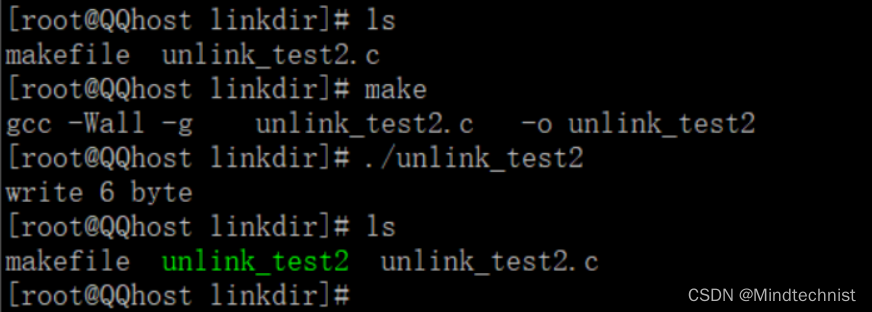Linux系统调用八、link系列API函数详解

🚀1. link函数
- 包含头文件
#include <unistd.h>
- 函数原型
int link(const char *oldpath, const char *newpath);
-
函数功能
link() creates a new link (also known as a hard link) to an existing file. 为现有的文件建立一个硬链接。
-
函数参数
- oldpath:源文件名(路径)
- newpath:硬链接文件名(路径)
-
函数返回值
- 成功返回0。On success, zero is returned.
- 失败返回-1并设置errno。On error, -1 is returned, and errno is set appropriately.
示例:传入现有的文件名并为该文件建立硬链接
/************************************************************
>File Name : link_test.c
>Author : QQ
>Company : QQ
>Create Time: 2022年05月16日 星期一 15时03分15秒
************************************************************/
#include <stdio.h>
#include <stdlib.h>
#include <unistd.h>
int main(int argc, char* argv[])
{
if(argc < 2)
{
printf("not found filename\n");
return -1;
}
link(argv[1], "./linkdir/link_test.c.hard");
return 0;
}
在执行程序时,参数oldpath和newpath不仅可以是文件名,也可以是带有路径的文件名。

🚀2. symlink函数
- 包含头文件
#include <unistd.h>
- 函数原型
int symlink(const char *oldpath, const char *newpath);
-
函数功能
symlink() creates a symbolic link named newpath which contains the string oldpath. 创建一个符号链接,也就是软链接。
-
函数参数
- oldpath:源文件名(路径)
- newpath:符号链接文件名(路径)
-
函数返回值
- 成功返回0。On success, zero is returned.
- 失败返回-1,并设置errno。On error, -1 is returned, and errno is set appropriately.
示例:传入现有的文件名并为该文件建立符号链接
/************************************************************
>File Name : symlink_test.c
>Author : QQ
>Company : QQ
>Create Time: 2022年05月16日 星期一 15时25分50秒
************************************************************/
#include <stdio.h>
#include <stdlib.h>
#include <unistd.h>
int main(int argc, char* argv[])
{
if(argc < 2)
{
printf("not found filename\n");
return -1;
}
symlink(argv[1], "symlink_test.c.soft");
return 0;
}

🚀3. readlink函数
- 包含头文件
#include <unistd.h>
- 函数原型
ssize_t readlink(const char *path, char *buf, size_t bufsiz);
-
函数功能
readlink() places the contents of the symbolic link path in the buffer buf, which has size bufsiz. readlink() does not append a null byte to buf. It will truncate the contents (to a length of bufsiz characters), in case the buffer is too small to hold all of the contents. 读取软链接,这个函数只能读取软链接,不能读取硬链接。
-
函数参数
- path:连接名(路径)
- buf:缓冲区(缓存读出的数据)
- bufsiz:缓冲区大小
-
函数返回值
- 成功返回缓冲区被填充的大小。On success, readlink() returns the number of bytes placed in buf.
- 失败返回-1且设置errno。On error, -1 is returned and errno is set to indicate the error.
/************************************************************
>File Name : readlink_test.c
>Author : QQ
>Company : QQ
>Create Time: 2022年05月16日 星期一 16时01分26秒
************************************************************/
#include <stdio.h>
#include <stdlib.h>
#include <unistd.h>
int main(int argc, char* argv[])
{
if(argc < 2)
{
printf("not found filename\n");
return -1;
}
char buf[10] = {0};
ssize_t ret = readlink(argv[1], buf, sizeof(buf));
printf("buf = %s, buflen = %ld, read size = %ld\n", buf, sizeof(buf), ret);
return 0;
}

🚀4. unlink函数
- 包含头文件
#include <unistd.h>
- 函数原型
int unlink(const char *pathname);
-
函数功能
unlink() deletes a name from the file system. 删除软链接、硬链接、文件。(注意同名命令unlink,查询函数man手册时要加章节2)
-
函数参数
- pathname:链接名,也可以是文件名
-
函数返回值
- 成功返回0。On success, zero is returned.
- 失败返回-1且设置errno。On error, -1 is returned, and errno is set appropriately.
示例1:unlink()删除文件、软链接、硬链接
/************************************************************
>File Name : unlink_test.c
>Author : QQ
>Company : QQ
>Create Time: 2022年05月16日 星期一 16时57分59秒
************************************************************/
#include <stdio.h>
#include <stdlib.h>
#include <unistd.h>
int main(int argc, char* argv[])
{
if(argc < 2)
{
printf("not found filename\n");
return -1;
}
unlink(argv[1]);
return 0;
}

示例2:write()写入unlink()删除的文件
/************************************************************
>File Name : unlink_test2.c
>Author : QQ
>Company : QQ
>Create Time: 2022年05月16日 星期一 17时13分37秒
************************************************************/
#include <stdio.h>
#include <stdlib.h>
#include <unistd.h>
#include <sys/types.h>
#include <sys/stat.h>
#include <fcntl.h>
int main()
{
int fd = open("hello.txt", O_WRONLY | O_CREAT, 0664);
unlink("hello.txt");
int ret = write(fd, "hello", sizeof("hello"));
if(ret < 0)
{
perror("write err");
}
else if(ret == 0)
{
printf("not write\n");
}
else
{
printf("write %d byte\n", ret);
}
return 0;
}

在这个实验中看到,虽然并没有hello.txt这个文件,但是write()函数返回了成功,也就是写入成功了,那么内容写到哪去了呢。实际上,unlink函数删除硬链接计数时,如果有进程在引用这个文件,那么将暂时先不删除文件,等进程退出后,再删除文件。实际上这个文件已经写入成功了,只不过在后面又被删除了,这有点像我们在网上听音乐或看视频时的缓存,也就是一个比实际进度更快的一个进度条,它会先把要看的内容缓存在一个临时文件(以便于看的时候更流畅),在看完后自动删除。







【推荐】国内首个AI IDE,深度理解中文开发场景,立即下载体验Trae
【推荐】编程新体验,更懂你的AI,立即体验豆包MarsCode编程助手
【推荐】抖音旗下AI助手豆包,你的智能百科全书,全免费不限次数
【推荐】轻量又高性能的 SSH 工具 IShell:AI 加持,快人一步
· 全程不用写代码,我用AI程序员写了一个飞机大战
· MongoDB 8.0这个新功能碉堡了,比商业数据库还牛
· 记一次.NET内存居高不下排查解决与启示
· DeepSeek 开源周回顾「GitHub 热点速览」
· 白话解读 Dapr 1.15:你的「微服务管家」又秀新绝活了